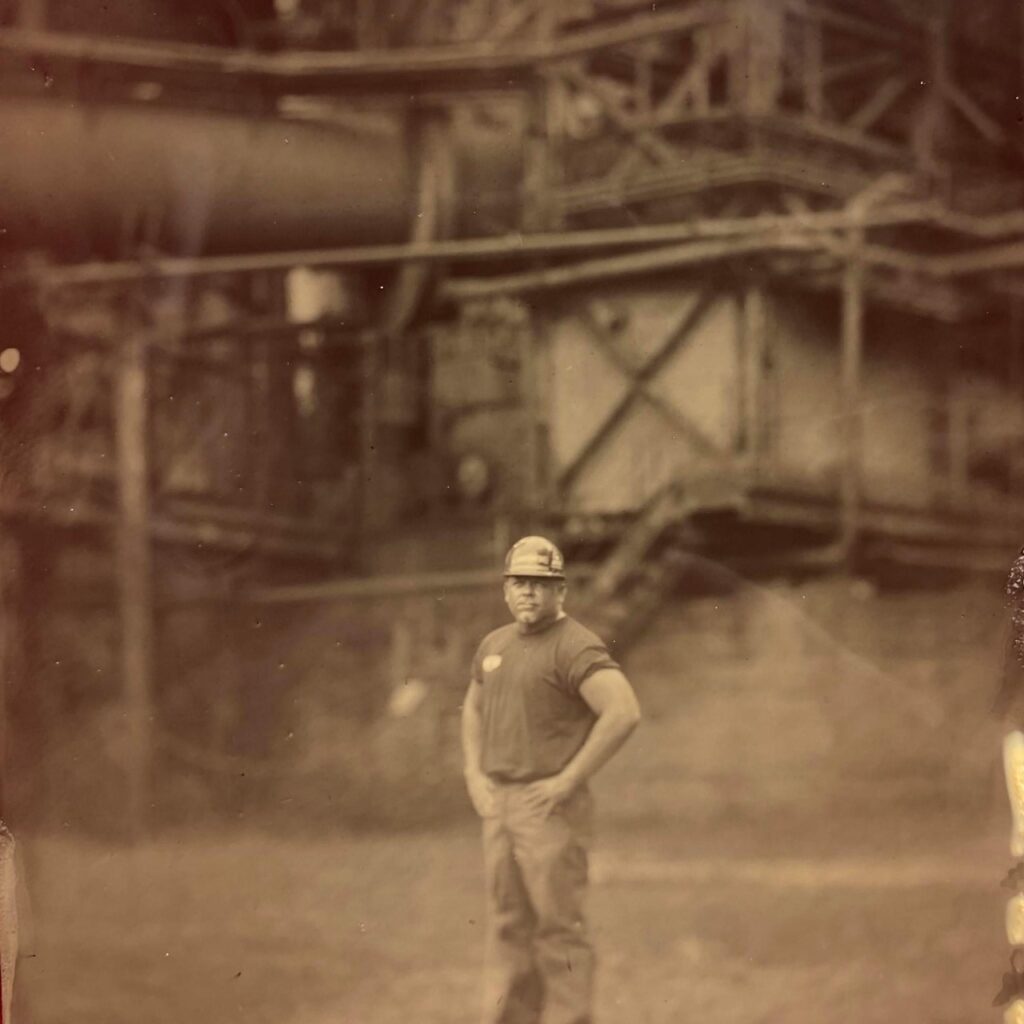
Jim Johnston was in the Oval Office when one president signed a proclamation putting Section 232 into effect. Now he wants another president to keep it in place.
Jim Johnston’s most memorable moment as a steelworker came on March 8, 2018.
That was the day Johnston joined a small group of United Steelworkers (USW) members at the White House to witness then-President Donald Trump sign a proclamation that invoked Section 232 trade action on steel and aluminum imports.
It was a surreal experience, and Johnston recalled that he was enamored by all the trappings of the Oval Office and the “People’s House.” It also was a fleeting moment, one that Johnston sometimes can’t believe really happened. After all, very few Americans get a behind-the-scenes inside look at the White House.
But Johnston is reminded every day of the business at hand in that game-changing moment. Section 232 gave lifeblood to a domestic steel industry that was being undercut by the dumping of artificially cheap foreign steel from countries like China, South Korea, India, Vietnam, Russia and Brazil.
Now, Johnston is counting on a new president to stand up for American-made steel. “President Biden needs to keep these tariffs both for the industry and the steelworkers,” he said.

Johnston was president of USW Local 1219 at U.S. Steel’s Edgar Thompson Works when Section 232 began. In his 17-year career as a steelworker, he knows firsthand the real-world impacts of the steel overcapacity crisis, as domestic manufacturers dealt with a flood of unfairly traded imports.
By 2018, many American steel companies had shut down or idled their operations, resulting in the layoffs of tens of thousands of steelworkers.
“Communist countries and others can’t continue to build these facilities with no environmental regulations or any labor regulations,” Johnston said. “They are paying people pennies on the dollar just to make them work just to flood the market and put people like us out of work and make our country weaker.
“The 232 tariffs were absolutely a solution to the overcapacity problem. It was just a shame we had to lose so many jobs waiting for these tariffs to come down, not just with U.S. Steel, but so many other companies that suffered in the meantime.”
Steelworkers fought for years to convince policymakers in Washington to act, Johnston recalled. By the time Section 232 was invoked in 2018, the crisis had become so bad that steel imports were a threat to U.S. economic and national security.
“You know, it was the steelworkers and some of the bigger corporations in the country that initiated the 232s. It wasn’t Donald Trump,” Johnston recalled. “He just reviewed it and signed it. They were sitting on his desk for several months before he actually put them into place. And during that delay, steel dumping even increased, and thousands of steelworker jobs were lost as countries like China tried to beat the tariff deadline.”
Removing the tariffs now, before a global solution to resolve steel overcapacity is put into place, would be a catastrophe for the U.S. steel industry, Johnston said.
So far, Biden is holding fast on his commitment to keep the tariffs in place. Administration officials like Commerce Secretary Gina Raimondo and U.S. Trade Representative Katherine Tai are among leaders who have said the tariffs are a tool for addressing overcapacity.
“If President Biden and his administration decide to make a change to the tariffs and just put quotas on, we need to have something in place that is going to make it an easier transition for us where we are not suffering from an influx of imports,” Johnston said. “We need a better avenue for a trade case instead of just having to lose jobs like we do to prove our case to the International Trade Commission to get a favorable trade ruling. I mean, it’s just not fair. We shouldn’t have to suffer that burden. We shouldn’t have to lose jobs just to get these tariffs put into place.”
The proof of success of Section 232 is in the numbers. A March 2021 study from the Economic Policy Institute found that more than 3,200 new direct steel jobs have been created, and $15.8 billion in direct investments have been announced. There’s been more investments announced since that study came out; both U.S. Steel and Nucor are planning to build new plants, while Cleveland Cliffs opened a new iron reduction facility in June.
“The 232 tariffs have absolutely helped,” Johnston said. “Right now, steel prices are probably the highest we’ve ever seen. The company is really profiting well. It took a while for that to take place. It wasn’t an initial shot in the arm, but it did give us what we needed.
“Currently we are seeing numbers that are great for not only our industry but our company as well for capital improvements in our mills. Last quarter, we got the biggest profit sharing our union members have ever seen. In August, steel was $2,100 a ton. In 2015, when we really started to see that surge of imports from China and South Korea, I think steel pricing was around $400 to $450 a ton. That’s because the global overcapacity was so great at that point.
“If Biden removed the 232 tariffs, obviously steel pricing is going to drop. It’s not going to allow us to make the money we are currently making. It’s not going to allow for companies to put the capital they need back into their facilities and be able to make the steel and compete on a global scale.”

At the age of 40, Johnston is a fifth-generation steelworker. Shortly after being re-elected Local 1219 president in 2018, he was appointed to the position of USW Mon Valley Joint Efforts Coordinator, where he handles pension benefits, training issues and contract matters for the three Mon Valley Works USW locals which represent Clairton Works, Edgar Thompson Works and Irvin Works.
Johnston began his steelmaking career as a general laborer at the blast furnace at Edgar Thompson Works near Pittsburgh. Throughout his career, he has held several jobs at the mill, including stints in the BOP shop and caster. He also has held many positions in the USW Local 1219 leadership.
“I’ve come a long way in these 17 years and it’s all because of the Steelworkers and the training and education they gave me,” Johnston said, noting he lives in the nearby suburb of Plum Boro, a desirable middle-class community. “I live a modest but good lifestyle because of the benefits of being a Steelworker.”
The three Mon Valley Works mills generally stay afloat because they are a low-cost producer and because of their proximity are considered fully integrated. There are approximately 2,700 USW members working in the Mon Valley triad.
But while Johnson is devoted to the USW members he represents in Pennsylvania, he also is concerned with the American steel industry and its skilled workers throughout the United States. He strongly feels the Section 232 tariffs are a necessity for all of America’s steelworkers.
“We’re concerned about us in the Mon Valley, but we are concerned about the smaller facilities like Conshohocken,” he said. “They mean just as much to us as my members do to me. I don’t want to see those tariffs go away. I mean, they make the steel for tanks. We need those facilities, and that’s what people don’t understand. It’s a small shop but they make armored plate. We can’t lose that.
“I think the facilities are finally starting to see the relief they need from the 232 tariffs,” he said. “I think right now it would be detrimental to take that away from us. We probably could have solved this last year if it wasn’t for Covid but right now, with things getting back to some normalcy with people going back to work and spending their money on American-made products, we are finally seeing some relief and reaping the benefits from the tariffs.
“If you want something that is reliable, it is made with American steel. We can make just about anything here in the Mon Valley and any investments or capital projects that local governments do, well, they shouldn’t have to rely on garbage which pretty much that imported Chinese stuff is.
“Not only was that investment as far as the tariffs and quotas on these other countries — especially the ones that manipulate their currency — good for us as steelworkers and people who produce in our industry, but it was good for the consumer as well because at the end of the day, they are going to get a product that’s going to last them. It’s not junk…
“We can outproduce and make better quality than anybody in the world. We should use our products and services first. The 232 tariffs will allow American steel companies to continue to make the most reliable steel in the world.”
